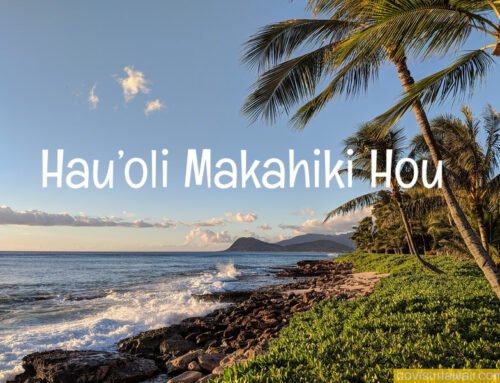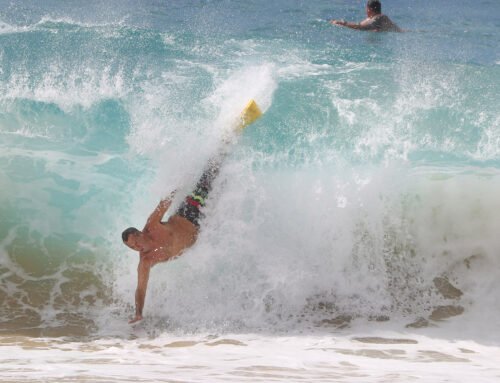There’s seven more days until Christmas, and retail merchants and shopping center managers are leaning into their busiest season of the year.
Still recovering from the pandemic lockdowns and grappling with what has been called the “retail apocalypse,” small businesses inside Oahu’s six biggest shopping centers are finding signs of holiday cheer as shoppers head for the malls.
What happens over the holidays is an important financial indicator for the broader economy, with December typically representing the highest sales volume of the year.


At Pearlridge Center, Oahu’s second-largest shopping mall, foot traffic has been almost restored to 2019 levels with about 30,000 shoppers per day in a market area that stretches from Salt Lake to Ewa Beach and from Mililani to Pearl City, according to David Cianelli, general manager.
“We’re optimistic,” Cianelli said. “Our traffic counts and sales are in line with last year, and 2022 was a very good year for us.”
‘Evolving To Customers’ Tastes’
Nationally, analysts have predicted that retail sales will rise a healthy 4% this year. It’s too early for any certainty, said Tina Yamaki, president of Retail Merchants of Hawaii, but she expects Hawaii’s sales volumes to mirror national levels.
“We’ve seen a lot more traffic; it seems like people are spending more this year,” Yamaki said.
Sherry Menor-McNamara, president and chief executive officer of Chamber of Commerce Hawaii, said she is “cautiously optimistic” that sales will be solid, based on what she has seen and heard at the shopping centers she has visited.
“Anecdotally, walking through, there’s a lot of activity,” she said. “Malls here are doing a good job of evolving to customer tastes.”


Seasonal activities are in full swing at Oahu’s large shopping centers, including Kahala Mall, Windward Mall in Kaneohe, International Market Place in Waikiki, Ka Makana Alii in Kapolei and at Ala Moana Center, the state’s largest shopping mall.
Nationwide and in Hawaii, brick-and-mortar stores have faced significant headwinds ever since Amazon introduced large-scale online commerce. In 2017, more than 12,000 physical stores closed as internet buying grew increasingly popular. Pandemic-related shutdowns in 2020 and 2021 added to the retail woes.
Popular full-line retailer Sears, heavily laden with debt, went bankrupt in 2018. As the company spiraled down, the Ala Moana store closed in 2013, the Windward Mall store in 2019, and the Pearlridge store in 2021.
Macy’s, now the subject of a $5.8 billion takeover offer, closed its downtown Honolulu store in 2013, its Kailua store in 2015 and its Windward Mall store early this year.
More than 150 malls out of about 1,100 in the U.S. have closed since 2018, according to analysts, with some surviving so marginally they have been called “zombie malls.” About 300 more are expected to fail within the next decade or so, for a death rate near 50%. Those that remain will need to transform themselves, analysts say
Retailers in Hawaii were particularly hard-hit by extended pandemic shutdowns and restrictions on operations, which were more stringent than many other parts of the country. By the end of 2020, some 10,000 retail workers had lost their jobs in the islands, according to the University of Hawaii Economic Research Organization.
Market Place ‘Close To Capacity’
Nonetheless, Oahu’s six large shopping centers generally appear to be recouping lost ground. There are some obvious changes: Hours are shorter, for example, and many national chain stores have departed. International Market Place lost its anchor, Saks Fifth Avenue, in 2022. But unlike on the mainland, no shopping malls have been shuttered. Target replaced Sears at Windward Mall and will open soon at International Market Place.
After losing several of the upscale retailers it featured after its redevelopment in 2016, International Market Place is now almost entirely leased, and is “pretty close to capacity,” said Malia Zannoni, marketing and sponsorship director at the shopping center.
Hawaii has one advantage in that local customers are loyal to malls they recall from childhood. In addition, shopping center managers have looked to be innovative, promote entertainment that draws shoppers and use the opportunity provided by lost national chains and newly vacant commercial space to develop and promote Hawaii-based firms that would have been priced out in the past.


Consequently, shopping centers seem to be maintaining their appeal in Hawaii, said David Edgar of Mililani, who moved to Hawaii from Massachusetts two years ago. On the mainland, he said, enclosed malls have fallen on hard times.
“Normally it seems like malls there are really dead, but here it’s busy,” he said, looking out over a holiday display at Pearlridge Center. “My experience of how malls are is from my life on the mainland, but there are a lot of people here. I’m always amazed.”
Unlike the mainland, where people can roam over several states to shop, in Hawaii “you have a captive audience,” Yamaki said. Local residents also tend to appreciate long-established holiday customs, including where they shop.
“We stay true to the local malls,” she said. “We like going there, we like shopping.”
Playing To Their Strengths
Some malls in Hawaii benefit from specific advantages. Ala Moana Center, which hit $1 billion in annual sales back in 1998, the first mall in the country to do so, is a high-end, international tourist destination. Ka Makana Alii has a Cheesecake Factory restaurant, which analysts say is often an indicator of likely success.
Cianelli said that Pearlridge benefits from having a nearby satellite city hall, medical facilities and office buildings.
“Some mainland centers don’t have those components, so they are having a difficult time,” he said. “We bring people here for more than shopping, so that’s why it has been rather successful.”


Creating attractions that generate foot traffic is part of the new survival strategy. At International Market Place, for example, the virtual reality arcade Odyssey VR opened a year ago.
“Giving people an experience is why we have maintained our customer traffic,” Cianelli said. “You need to offer a variety of reasons to be there.”
Not all the attractions are new. At Pearlridge, one long-standing tradition is the kids’ holiday train, which runs in a circle loop in the center of the mall. It’s a big draw for parents and children.
The holiday train was a lure for Ashley Agmata, who brought her two daughters, ages 3 and 4, to the mail on a recent Wednesday afternoon. The girls stepped off the train, squealing with delight, and as she led them down the corridor, Agmata told them to remember the details so they could tell their father about it that night. The train is a family destination, she said.
“We knew it would be here,” she said. “So we knew we would come.”
Youthful Attractions
Malls remain a magnetic attraction for many Oahu teenagers.
Cradling a huge bag of Volcano popcorn, flavored with butter, furikake and mochi crunch, Shayla Repoza, 12, said she goes to Windward Mall at least twice a week, sometimes twice a day, and thinks it is a better experience than shopping online.
“I like to see what there is, and if I really like it,” she said. “Online, I don’t know if it is good or not.”
Many local children head to the malls over the holidays to perform in musical reviews, often with extended family members in tow as their audience.


Tuba player Jimmy Wu, 16, a student at Moanalua High School, greeted friends after performing holiday tunes at Ala Moana’s Centerstage on Thursday night. His younger sister proudly said her brother was one of only five musicians at the high school selected to perform at Ala Moana.
All the shopping centers offer special events for the holidays. At Ka Makana Alii in Kapolei, children cavorted in “snowflakes” produced by a snow-making machine attached to a towering Christmas tree. Nearby, other children had their faces painted. A family of six, including two grandparents and two children, showed up for their annual pictures with Santa Claus dressed in matching red and white Christmas pajamas.
Hundreds of children, meanwhile, lined up for a Christmas performance by Halau Hula O Hokulani, a hula school that operates at the shopping center.
The Cabuena family of Waipahu likes to go to Ka Makana Alii for the holidays.
“The kids can run around,” said their mother, Elena. Her husband, Brandon, added that he prefers shopping in person rather than online because “when you order online, things are too small or too big.”
Going Local Proves Profitable
The national retailing slump is also proving to be an opportunity for Hawaii-based businesses. At Pearlridge Center, 60% of the restaurants are now Hawaii-based, Cianelli said.
Mister Sangria, which features craft cocktails made with only local ingredients, opened in the heart of the mall, near the escalators, in February. A chilled carafe filled with lychee martinis rested on the counter as shoppers bustled by just a few feet away from the bartender.
There’s a growing Hawaii food focus at the International Market Place, too, where seven of the eight retailers on the third floor Grand Lanai are based in Hawaii. They include Eating House 1849, Crackin’ Kitchen, Liliha Bakery, Moani Waikiki, Skybox Taphouse, Herringbone and Shorefyre. When the shopping center reopened in 2016, many of the restaurants were based elsewhere.


Other types of Hawaii-based businesses are also finding new footholds in the malls.
Happy Koi Nursery, which sells indoor house and office plants potted in hand-crafted cement containers, had been operating as a pop-up at Pearlridge for 20 years but established a permanent location there just as the Covid shutdown started to be lifted. At one point, it was one of only four stores operating in the mall. Positioned under an atrium skylight in the mall’s center, the location has been successful for the family-owned firm.
“We’re doing very well,” said co-owner Brian Pane’e, gesturing overhead to the atrium. “The mall was built for the kind of business we have.”
In the past, he said, it was more difficult for a small local business to get launched. Mall managers seemed to prefer national retailers with more standardized product lines. Pearlridge has welcomed him as a local business that diversifies its product mix, he said.
New industry research suggests brick-and-mortar retailing is converging more easily with online shopping than in the past, as stores find that customers who come to browse will go on their internet sites later to purchase products they viewed in person.
“We don’t look at it as us-versus-them anymore,” Cianelli said. “The physical fits in with online.”
The Big Island-based owners of KoaWood Ranch, which opened its doors at International Market Place last month, featuring home décor, apparel and items crafted from local wood, say they see new opportunities for retailers of authentic Hawaii merchandise.
“There are very dramatic shifts in retailing broadly,” said co-owner Mike Amado. “The big old department stores are cycling out. Now you aren’t just selling a product but the story behind it.”







Leave A Comment